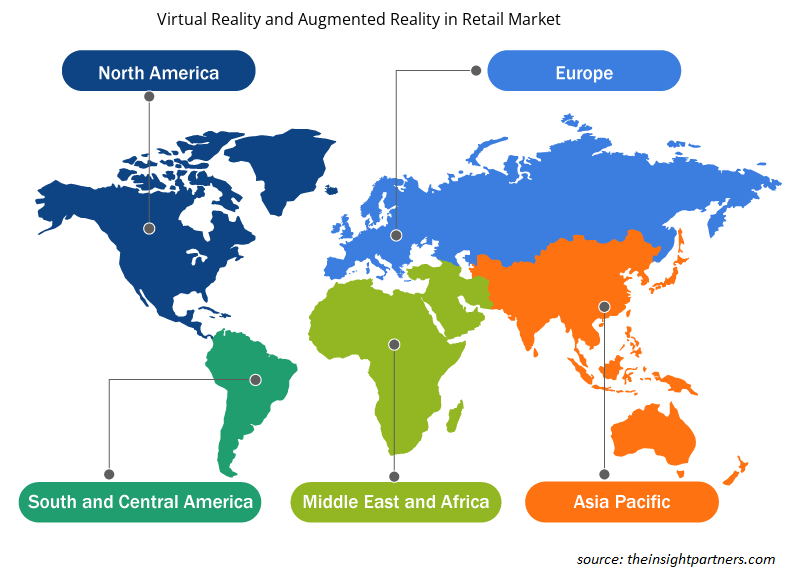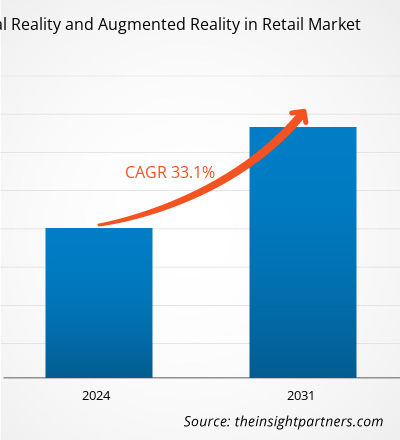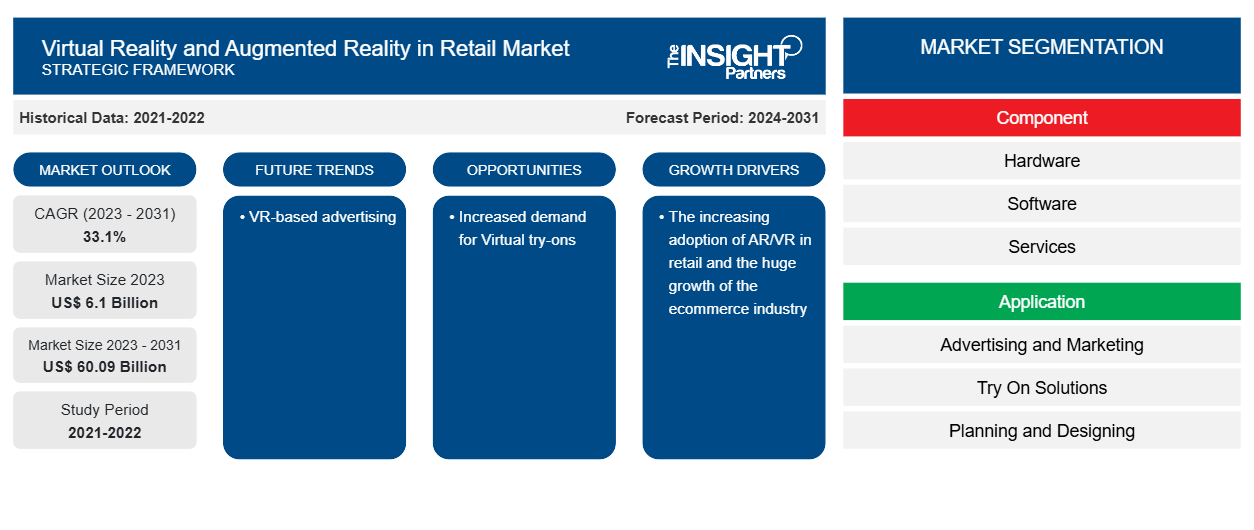零售业虚拟现实和增强现实规模预计将从 2023 年的 61 亿美元增至 2031 年的 600.9 亿美元。零售业虚拟现实和增强现实预计在 2023-2031 年期间的复合年增长率为 33.1%。基于 VR 的广告很可能仍是市场的主要趋势。
零售市场分析中的虚拟现实和增强现实
由于当前的市场趋势及其在预测期内可预见的影响,零售业中的虚拟现实和增强现实具有增长前景。零售业中虚拟现实和增强现实的增长得益于零售业中 AR/VR 的日益普及以及电子商务行业的迅猛发展等因素。虚拟试穿需求的增加为零售业中的虚拟现实和增强现实提供了有利可图的机会。
零售市场概览中的虚拟现实和增强现实
虚拟现实 (VR) 和增强现实 (AR) 正在通过提供沉浸式和互动式购物体验改变零售业格局。VR 创造了一个完全数字化的环境,客户可以在其中探索虚拟商店、以 3D 形式查看产品,甚至可以虚拟试穿衣服。另一方面,AR 将数字信息叠加到现实世界中,让购物者能够使用智能手机应用程序或智能镜子查看家具在家中的样子,或者化妆后在脸上的效果。这两种技术都使零售商能够弥合在线购物和店内购物之间的差距,增强产品可视化,减少退货,并创造引人入胜的品牌体验,从而推动客户参与和销售。
定制此报告以满足您的需求
您可以免费定制任何报告,包括本报告的部分内容、国家级分析、Excel 数据包,以及为初创企业和大学提供优惠和折扣
-
获取此报告的关键市场趋势。这个免费样品将包括数据分析,从市场趋势到估计和预测。
零售市场中的虚拟现实和增强现实的驱动因素和机遇
零售业越来越多地采用 AR/VR 以利于市场发展
受数字时代影响的主要行业之一是零售业。沃尔玛、阿里巴巴和亚马逊等大型零售商积极投资尖端零售技术,以便为客户提供更加个性化和互动的服务。智能零售的三个基本要素是提高便利性、个性化和定制化。AR 和 VR 驱动的应用程序等创新解决方案越来越受欢迎。继 Wayfair、Lowe's 和宜家等零售巨头之后,许多零售企业也开始采用 AR/VR 技术。例如,预计将有超过 10 亿人使用增强现实产品。这个数字令人震惊。虚拟现实和增强现实使客户在购买前更容易识别和试用产品。使用增强现实,大型购物中心的导航将变得更加容易。
虚拟试穿需求增加
虚拟试穿需求的增加为 VR 和 AR 在零售市场增长中提供了重大机遇。通过让客户在购买前更准确地看到产品,虚拟试穿可以显著降低退货率。这为零售商节省了运输和补货费用,提高了盈利能力。此外,随着客户通过虚拟试穿对在线购物的信心增强,他们更有可能在没有亲眼看到商品的情况下购买商品。这可以促进电子商务销售,尤其是在服装和化妆品等类别。虚拟试穿提供了一种新颖的互动式购物体验,可以提高客户的参与度和满意度。这可以提高品牌忠诚度和重复购买。
零售市场中的虚拟现实和增强现实报告细分分析
在零售市场分析中,促成虚拟现实和增强现实衍生的关键部分是组件、应用程序和零售类型
- 根据组件,零售市场的虚拟现实和增强现实分为硬件、软件和服务。硬件部分将在 2023 年占据相当大的市场份额。
- 根据应用,市场细分为广告和营销、试穿解决方案、规划和设计等。广告和营销部门在 2023 年占据了最大的市场份额。
- 就零售类型而言,市场细分为珠宝、服装、美容和化妆品、家具等。服装细分市场在 2023 年占据了最大的市场份额。
零售市场虚拟现实和增强现实的地域份额分析
零售市场中的虚拟现实和增强现实报告的地理范围主要分为五个地区:北美、亚太、欧洲、中东和非洲、南美和中美。
亚太地区零售业对增强现实 (AR) 和虚拟现实 (VR) 的使用正在日益增多。这些技术正以各种方式被越来越多地利用,以增强零售体验并提高客户参与度。这些技术有潜力增强零售体验、提高客户参与度,并为行业营销、培训和教育提供新的机会。
零售市场中的虚拟现实和增强现实区域洞察
Insight Partners 的分析师已详细解释了预测期内影响零售市场虚拟现实和增强现实的区域趋势和因素。本节还讨论了零售市场中的虚拟现实和增强现实的细分市场和地理位置,包括北美、欧洲、亚太地区、中东和非洲以及南美洲和中美洲。

- 获取零售市场虚拟现实和增强现实的区域特定数据
零售市场中的虚拟现实和增强现实报告范围
| 报告属性 | 细节 |
|---|---|
| 2023 年的市场规模 | 61亿美元 |
| 2031 年市场规模 | 600.9 亿美元 |
| 全球复合年增长率(2023 - 2031) | 33.1% |
| 史料 | 2021-2022 |
| 预测期 | 2024-2031 |
| 涵盖的领域 |
按组件
|
| 覆盖地区和国家 |
北美
|
| 市场领导者和主要公司简介 |
|
零售市场参与者密度中的虚拟现实和增强现实:了解其对业务动态的影响
零售市场中的虚拟现实和增强现实市场正在快速增长,这得益于终端用户需求的不断增长,这些需求源于消费者偏好的不断变化、技术进步以及对产品优势的认识不断提高等因素。随着需求的增加,企业正在扩大其产品范围,进行创新以满足消费者的需求,并利用新兴趋势,从而进一步推动市场增长。
市场参与者密度是指在特定市场或行业内运营的企业或公司的分布情况。它表明在给定市场空间中,相对于其规模或总市场价值,有多少竞争对手(市场参与者)存在。
在零售市场运营虚拟现实和增强现实的主要公司有:
- 爱普生美国公司
- 马克思恩格斯
- 谷歌有限责任公司
- 印孚瑟斯公司
- 英特尔公司
- 微软公司
免责声明:上面列出的公司没有按照任何特定顺序排列。

- 了解零售市场虚拟现实和增强现实的主要参与者概况
零售市场中的虚拟现实和增强现实新闻和最新发展
通过收集一手和二手研究的定性和定量数据来评估零售市场的虚拟现实和增强现实,其中包括重要的公司出版物、协会数据和数据库。以下列出了零售市场虚拟现实和增强现实的一些发展:
- Apple 发布了首款混合现实耳机 Vision Pro,其中包含 600 款新应用和游戏。其中包括各大零售商进军增强现实 (AR) 和虚拟现实 (VR) 领域的尝试,利用这些功能为消费者提供更具互动性的电子商务之旅。Vision Pro 应用为耳机用户提供 3D 购物体验,使他们能够浏览产品和搭配服装。此外,Apple SharePlay 功能与 FaceTime 视频通话的集成使零售商能够在这种逼真的环境中提供造型师的实时建议。(来源:Apple,新闻稿,2024 年 2 月)
- Zero10 通过利用店内和橱窗展示的 AR 镜子为 Tommy Hilfiger 和 Coach 等品牌提供数字解决方案。Tommy Hilfiger 还在欧洲使用科技公司 Zero10 的 AR 镜子作为其 Shawn Mendes 活动的一部分,并宣传他们最近推出的羽绒夹克。与此同时,Coach 使用 Zero10 的 AR 镜子和 AR 店面来宣传他们的 Tabby 包和假日季活动(来源:Zero10,新闻稿,2024 年 4 月)
零售市场中的虚拟现实和增强现实报告范围和交付成果
“零售市场规模和预测中的虚拟现实和增强现实(2021-2031)”报告对以下领域进行了详细的市场分析:
- 虚拟现实和增强现实在零售市场的规模以及范围涵盖的所有关键细分市场的全球、区域和国家层面的预测
- 零售市场趋势中的虚拟现实和增强现实,以及驱动因素、限制因素和关键机遇等市场动态
- 详细的 PEST/波特五力分析和 SWOT 分析
- 零售市场分析中的虚拟现实和增强现实,涵盖关键市场趋势、全球和区域框架、主要参与者、法规和最新市场发展
- 行业格局和竞争分析,涵盖市场集中度、热图分析、知名参与者以及零售市场虚拟现实和增强现实的最新发展
- 详细的公司简介
- 历史分析(2 年)、基准年、预测(7 年)及复合年增长率
- PEST和SWOT分析
- 市场规模、价值/数量 - 全球、区域、国家
- 行业和竞争格局
- Excel 数据集
近期报告
客户评价
购买理由
- 明智的决策
- 了解市场动态
- 竞争分析
- 客户洞察
- 市场预测
- 风险规避
- 战略规划
- 投资论证
- 识别新兴市场
- 优化营销策略
- 提升运营效率
- 顺应监管趋势























 获取免费样品 - 零售市场中的虚拟现实和增强现实
获取免费样品 - 零售市场中的虚拟现实和增强现实